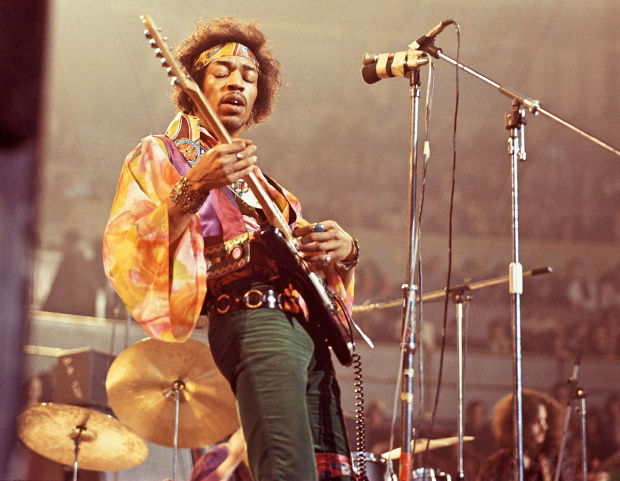
By Julianna Tassi
When it comes to rock and roll, the ideals and techniques of guitar playing have been altered and added to by many iconic musicians. Though they are all very different in their styles, each of these guitarists has greatly influenced and inspired revolutionary changes in how the instrument is played and heard. With a background in blues and jazz methods, rock and roll guitar varies in many different ways between time periods as well as between artists. Listed in no particular order, these musicians widely impacted many new ideas and styles to come after them.
- Eric Clapton – Commonly known as a god of rock and roll guitar, Clapton worked as a member of the Yardbirds, Cream, Derek and the Dominos, and many more bands. His solo career pushed his popularity even further. He includes a major blues influence in all of his work. Clapton revolutionized the sound of the electric guitar and opened up endless opportunities to many musicians after him.
- Jimi Hendrix – Jimi Hendrix, my personal favorite guitarist, brought a new sound to the music world in the 1960s. Many artists including Stevie Ray Vaughan and Kenny Wayne Shepherd were very deeply influenced by the works of Hendrix. He is the face of iconic music festival Woodstock of 1969. He interestingly combined themes of psychedelic rock and blues to find a new genre of rock and roll.
- B.B. King – King was one of the very first pioneers of electric guitar playing itself. Though often categorized as a blues musician (nickname: “King of the Blues”), he influenced essentially all rock and roll guitarists who came after him. He publicised never before seen techniques including vibrato and string bending which was seen to be very sophisticated.
- Stevie Ray Vaughan – Vaughan, commonly known as SRV, is often considered the artist who incorporated blues into rock and roll the most. Hendrix was by far his greatest inspiration, as seen through the many blues and jazz techniques that SRV picked up from him. Easily recognized by his raw guitar sound and tasteful solos, Vaughan’s legacy still carries out to countless musicians today.
- Chuck Berry – Often associated with similar influence as B.B. King, Chuck Berry introduced many new ideas of music to the newfound world of rock and roll. He developed rhythm and blues into a style of rock that made the genre distinctive and unique by utilizing specific techniques into guitar solos. He showed the first signs of live energy and showmanship that inspired ideas of stage presence that is commonly seen today.
- Jimmy Page – From experiences with the Yardbirds to Led Zeppelin, Page is very commonly considered one of the greatest guitarists and musicians of all time. His iconic riffs are known to be almost messy in such a strong, powerful way that is so tasteful and easily recognizable to any listener. He popularized the use of Gibson Les Pauls as well as double-necked Gibsons which opened up limitless opportunities to guitar playing. He established countless new ideas regarding recording and producing sounds with different effects.
- Eddie Van Halen – Eddie Van Halen introduced many new ideas of guitar playing in the Hair Metal era which took many listeners by surprise. He is known for bringing the tapping technique (playing with hands on the neck) into rock and roll music. His use of vibrato, tremolo picking, and harmonics combined to create a new sound of the electric guitar. Van Halen’s iconic instrumental “Eruption” showcased this style and inspired many guitarists who followed.
- Tony Iommi – Iommi’s iconic heavy, crunchy riffs completely reinvented the world of rock and roll. Black Sabbath is known to be mainly the first rock band to popularize the heavy metal genre. Iommi was known for layering guitar solos in songs as well as switching tempos and chord progressions as breakdowns in many of their pieces. He played with thimbles on his left fingertips due to an accident earlier in his life. He didn’t let this hold him back; he showcased his abilities broadly from Black Sabbath to Heaven & Hell to Jethro Tull.
- Al Di Meola – Though most often considered jazz-driven, Di Meola opened up endless new opportunities for rock and roll guitarists throughout decades to come. He’s known to be one of the first known “shredders” of guitar, even through his jazz-fusion roots. Between working with Return to Forever and succeeded further with his solo career, Di Meola introduced many new techniques to the instrument. His fast, complex compositions blew away listeners and changed what they knew about music itself.
- Ritchie Blackmore – Best known for being the lead guitarist of Deep Purple, Blackmore is often considered one of the best metal guitarists. He is also associated with the early shredders of rock and roll. Blackmore’s legendary solos and guitar riffs demonstrate his distinctive style branched from hard rock. He had a passion for classical music, which he noticeably incorporated into his songs.
Honorable mentions: Jeff Beck, Frank Zappa, Yngwie Malmsteen, Randy Rhoads, Kirk Hammett, Carlos Santana, Keith Richards, David Gilmour, Alex Lifeson, Pete Townshend, Slash, and Michael Schenker